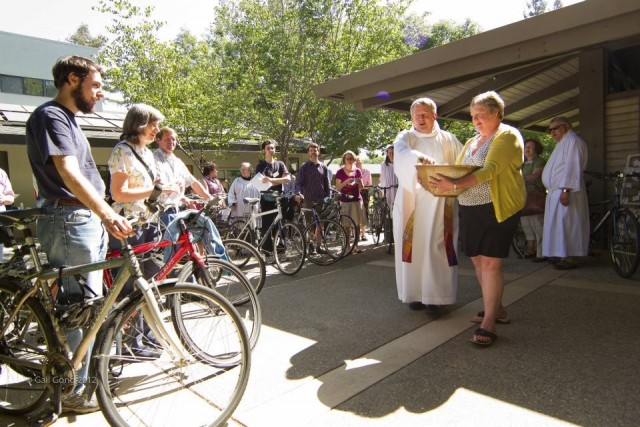Deseret New recently posted an article on religious rituals; why they’re important and the emergence of new ones.
“If a bomb fell on a wedding celebration before the cake was cut, would the couple still be married? This was the question posed to the Rev. Matthew Seddon and his classmates in their college course on rituals. Most people think, “Yes, of course.” They say the marriage was sealed with the exchange of vows or those familiar words, “I now pronounce you husband and wife.”
But for the Rev. Seddon, the cake is crucial. Guests don’t start leaving until after the cake is cut, he’d tell his classmates. It leads to “a collective sigh,” like the event has come to an end. The Rev. Seddon has since become an expert on rituals, having studied the practice as an archaeologist. He now performs them as an Episcopal priest at St. John’s Episcopal Church in Austin, Texas.
Rituals are a timeless part of humanity’s efforts to understand and interact with forces beyond their control and ken. “”We have a human need to recognize and mark transitions and to help people through them,” the Rev. Seddon said.”
But modern life offers transitions and life events that wouldn’t have been in the minds of those who formed many of the rituals that we commonly share now; things like divorce, retirement, starting school, or a new bike
All the rituals we’ve inherited only take us so far in terms of the needs of contemporary people and the experiences we’re having,” Rabbi Laura Geller, rabbi emeritus at Temple Emanuel of Beverly Hills, California, said.
New rituals must be formed and old rituals adjusted as a faith tradition grows and change. For example, some Jewish communities are working to include girls in ceremonies once reserved for boys. Rabbi Handler and her husband borrowed pieces of the traditional ritual performed when a Jewish boy receives his first haircut when they cut their daughter Dahlia’s hair for the first time.
“We said a blessing and she ate a little honey. We did a symbolic haircut at home with family members,” before going to the salon, Rabbi Handler said.
On a broader level, increased energy around ritual formation may grow out of the rise of religious “nones,” or Americans who don’t affiliate with a particular religious group, the Rev. Seddon said. In 2014, 22.8 percent of U.S. adults were religiously unaffiliated, compared to 16.1 percent in 2007, according to Pew Research Center.
“As society becomes increasingly secular, we lose” community commemorations of transitions, he said. “There may be new interest in (rituals) as people feel bereft of these things that humans have done for thousands of years.”
But creating new rituals should be done with care and not taken lightly.
“Ritual formation is a tricky process, religious experts said. Church members don’t always agree on how well-established rituals function, as the Rev. Seddon’s wedding cake argument illustrates, or how to ensure that a new ceremony is distinctly Episcopalian or Jewish or Islamic. “Creating new rituals is extremely dangerous. Unless you do it well, you run the risk of undermining traditional rituals,” said Rabbi Geller.
Formal religious rituals, however, are harder to design and impact entire communities, the Rev. Seddon said. “I need to be careful to put (a new ritual) together within the bounds of Episcopal tradition,” he said. “I can’t sacrifice a chicken on the altar without having someone call the bishop and complain about me.”
He brought up the wedding ceremony question because it illustrates how rituals can be familiar and mysterious at the same time. When a ritual is done well, it feels right and it honors the faith tradition in which it’s performed. But it’s easy to get it wrong.
“I try to draw on tradition to help me do something that isn’t going off the rails,” the Rev. Seddon said.
When participants at the Episcopal Church’s General Convention voted to create a new ritual resource, a committee of priests and lay people with an interest in liturgy and music worked for years to produce “Changes: Prayers and Services Honoring Rites of Passage,” which was released in 2007. They had to figure out an appropriate, Episcopal way to celebrate learning to ride a bike or mourn the loss of a pet.
Ultimately, formal ritual creation needs to be a work rooted in the community of faith in which it is enacted.
Both Rabbi Geller and the Rev. Seddon emphasized the importance of creating rituals with a faith community in mind. Creators should be guided by a denomination’s whole collection of beliefs and practices, as well as other rituals. For example, when the Rev. Seddon has to put together a service for an event that isn’t mentioned in “Changes,” he’ll dig through the book for related rituals and turn to other church leaders for advice. “I try to draw on the collective wisdom of the community,” he said. The goal isn’t to make the process overly burdensome. Instead, it’s to find the right way to invite God into a special moment. Ritual creation “is a sacred opportunity to pay attention to the divinity of the experience,” Rabbi Geller said.
this article is drawn from the article by Kelsey Dallas of Deseret News
image: Blessing of the Bikes at the Church of St Martin in Davis, CA

